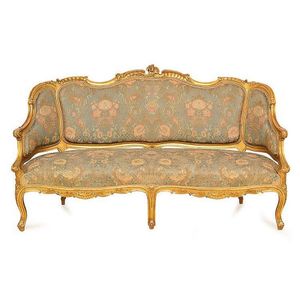Mahogany Regency Settee with Navy Laurel Fabric
You must be a subscriber, and be logged in to view price and dealer details.
Subscribe Now to view actual auction price for this item
When you subscribe, you have the option of setting the currency in which to display prices to $Au, $US, $NZ or Stg.
- Turning - Any part of a piece of furniture that has been turned and shaped with chisels on a lathe. Turned sections include legs, columns, feet, finials, pedestals, stretchers, spindles etc. There have been many varieties and fashions over the centuries: baluster, melon, barley-sugar, bobbin, cotton-reel, rope-twist, and so on. Split turning implies a turned section that has been cut in half lengthwise and applied to a cabinet front as a false decorative support.
- Laurel Leaf - The use of the laurel leaf as a decorative element can be traced back to ancient Greece and Rome, where it was closely associated with victory and honour. In these cultures, the laurel was a sacred tree that was dedicated to the god Apollo and was believed to have protective and healing properties.
In ancient Greece, the laurel wreath was awarded to victors in athletic competitions, such as the Olympic Games, as a symbol of their achievement. The wreath was also associated with academic achievement, and was often worn by scholars and poets. The Greeks also used the laurel leaf as a symbol of victory in war, and it was often depicted in artwork alongside images of triumphant warriors and heroes.
The Romans continued this tradition, and the laurel wreath became a symbol of the highest military honor, the triumph, awarded to victorious generals. The wreath was also used to crown emperors and other important officials, and was often depicted in Roman art and architecture as a symbol of power and authority.
The laurel leaf is still used as a symbol of achievement, success, and excellence, and is frequently used in logos, emblems, and other branding materials. Its association with victory and honour has made it a popular choice for awards, medals, and other forms of recognition. - Turned Legs - are legs which have been turned on a lathe. In use from the 16th century, turned legs on tables, chairs and cabinets became more frequent until, by the 1830s, the Georgian square or tapered leg was rarely found except in country pieces.
- Regency Period - The Regency period in English furniture design refers to the period when King George III, was declared unfit to rule in 1811, and his son ruled as proxy as Prince Regent, until 1820, and then, after the death of his father as George IV until his death in 1830. The Regency period was preceded by the Georgian period (George I, George II, and George III: 1714 - 1811), and was followed by the William IV period, which only lasted until 1837 when William IV died as was succeeded by Queen Victoria.
- Mahogany - Mahogany is a dense, close grained red-coloured timber from the West Indies and Central America. It was first imported into Europe in the the early 18th century and its use continued through the 19th century. It was popular for furniture making because of its strength, the wide boards available, the distinctive grain on some boards, termed flame mahogany and the rich warm colour of the timber when it was polished.. The "flame" was produced where a limb grew out from the trunk of the tree, and this timber was usually sliced into veneers for feature panels on doors, backs and cornices.
Some terms used to describe mahogany relate to the country from which it originally came, such as "Cuban" mahogany, "Honduras" mahogany etc. However unless the wood has been tested the names assigned are more a selling feature, rather than a true indication of the timber's origin. - Castors - Wheels, fitted especially to chair legs, couches, tables and some smaller pieces of furniture, to enable them to be easily moved about. The earliest castors were of brass, with shanks fitting into the base of the leg, and the wheels often made of leather. In the late 18th century, brass 'bucket' or 'cup' castors were introduced, either rounded or square, fitting directly over the end of the leg and held in place with screws. The wheels were generally solid brass. Bucket/cup castors continued in use throughout the 19th century and indeed are still made today. In the later 19th century wheels were sometimes made of wood, china, either white or brown, and sometimes of steel.
This item has been included into following indexes:
Visually similar items

An Australian cedar double ended settee with green velvet upholstery, circa 1835, 92 cm high, 220 cm wide, 60 cm deep

A fine Colonial cedar double ended settee c1840s. Elaborately carved Thomas Hope back, scrolling arms all resting turned & reeded legs. Upholstered in a tasteful green fabric with woven gold stars. Height 106 cm, width 225 cm, depth 65 cm. Provenance: The

An early Australian cedar double ended settee upholstered in black cloth, circa 1830's. 95 cm high, 220 cm wide, 64 cm deep

A Louis XV style giltwood canape the shaped back and fitted seat upholstered in floral cloth, the frame with shell and leaf carving, cabriole legs, 164 cm wide
